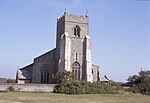St Margaret's, Cley

St Margaret's is the Anglican parish church of Cley next the Sea, Norfolk, in the deanery of Holt, the Archdeaconry of Lynn and the Diocese of Norwich. The dedication is to St Margaret of Antioch. It is the largest church in the Blakeney Haven area, with a nave to match, and was rebuilt from the 1320s to the mid-1340s. Before the end of the 14th century, a large south porch was added. The north and south transepts are derelict. The style is mainly Perpendicular, with some Decorated, and an early English style chancel.It has an octagonal font, carved wooden bench ends and Decorated tracery, and a carved rood screen. St Margaret's is a nationally important building, with a Grade I listing for its exceptional architectural interest.The church has a large number of war memorials.
Excerpt from the Wikipedia article St Margaret's, Cley (License: CC BY-SA 3.0, Authors, Images).St Margaret's, Cley
Church Lane, North Norfolk Cley Next The Sea
Geographical coordinates (GPS) Address Website External links Nearby Places Show on map
Geographical coordinates (GPS)
| Latitude | Longitude |
|---|---|
| N 52.946388888889 ° | E 1.0475 ° |
Address
Saint Margaret's Church
Church Lane
NR25 7TS North Norfolk, Cley Next The Sea
England, United Kingdom
Open on Google Maps










